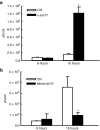Human metapneumovirus infection induces significant changes in small noncoding RNA expression in airway epithelial cells
- PMID: 24845106
- PMCID: PMC4040629
- DOI: 10.1038/mtna.2014.18
Human metapneumovirus infection induces significant changes in small noncoding RNA expression in airway epithelial cells
Abstract
Small noncoding RNAs (sncRNAs), such as microRNAs (miRNA), virus-derived sncRNAs, and more recently identified tRNA-derived RNA fragments, are critical to posttranscriptional control of genes. Upon viral infection, host cells alter their sncRNA expression as a defense mechanism, while viruses can circumvent host defenses and promote their own propagation by affecting host cellular sncRNA expression or by expressing viral sncRNAs. Therefore, characterizing sncRNA profiles in response to viral infection is an important tool for understanding host-virus interaction, and for antiviral strategy development. Human metapneumovirus (hMPV), a recently identified pathogen, is a major cause of lower respiratory tract infections in infants and children. To investigate whether sncRNAs play a role in hMPV infection, we analyzed the changes in sncRNA profiles of airway epithelial cells in response to hMPV infection using ultrahigh-throughput sequencing. Of the cloned sncRNAs, miRNA was dominant in A549 cells, with the percentage of miRNA increasing in a time-dependent manner after the infection. In addition, several hMPV-derived sncRNAs and corresponding ribonucleases for their biogenesis were identified. hMPV M2-2 protein was revealed to be a key viral protein regulating miRNA expression. In summary, this study revealed several novel aspects of hMPV-mediated sncRNA expression, providing a new perspective on hMPV-host interactions.
Figures






Similar articles
-
Non-Coding RNAs and Their Role in Respiratory Syncytial Virus (RSV) and Human Metapneumovirus (hMPV) Infections.Viruses. 2020 Mar 21;12(3):345. doi: 10.3390/v12030345. Viruses. 2020. PMID: 32245206 Free PMC article. Review.
-
Human Metapneumovirus-Induced Host microRNA Expression Impairs the Interferon Response in Macrophages and Epithelial Cells.Viruses. 2023 Nov 18;15(11):2272. doi: 10.3390/v15112272. Viruses. 2023. PMID: 38005948 Free PMC article.
-
Respiratory Syncytial Virus and Human Metapneumovirus Infections in Three-Dimensional Human Airway Tissues Expose an Interesting Dichotomy in Viral Replication, Spread, and Inhibition by Neutralizing Antibodies.J Virol. 2020 Sep 29;94(20):e01068-20. doi: 10.1128/JVI.01068-20. Print 2020 Sep 29. J Virol. 2020. PMID: 32759319 Free PMC article.
-
Varicella-Zoster Virus Expresses Multiple Small Noncoding RNAs.J Virol. 2017 Nov 30;91(24):e01710-17. doi: 10.1128/JVI.01710-17. Print 2017 Dec 15. J Virol. 2017. PMID: 29021397 Free PMC article.
-
Insights into the regulatory role of bacterial sncRNA and its extracellular delivery via OMVs.Appl Microbiol Biotechnol. 2024 Dec;108(1):29. doi: 10.1007/s00253-023-12855-z. Epub 2023 Dec 30. Appl Microbiol Biotechnol. 2024. PMID: 38159117 Review.
Cited by
-
The role of microRNAs in respiratory viral infection: friend or foe?Rev Med Virol. 2016 Nov;26(6):389-407. doi: 10.1002/rmv.1894. Epub 2016 Jul 4. Rev Med Virol. 2016. PMID: 27373545 Free PMC article. Review.
-
The Importance of miRNA Identification During Respiratory Viral Infections.J Cell Immunol. 2021;3(4):207-214. doi: 10.33696/immunology.3.101. J Cell Immunol. 2021. PMID: 34541575 Free PMC article.
-
Parent tRNA Modification Status Determines the Induction of Functional tRNA-Derived RNA by Respiratory Syncytial Virus Infection.Viruses. 2022 Dec 24;15(1):57. doi: 10.3390/v15010057. Viruses. 2022. PMID: 36680097 Free PMC article.
-
Small Non-coding Transfer RNA-Derived RNA Fragments (tRFs): Their Biogenesis, Function and Implication in Human Diseases.Genomics Inform. 2015 Dec;13(4):94-101. doi: 10.5808/GI.2015.13.4.94. Epub 2015 Dec 31. Genomics Inform. 2015. PMID: 26865839 Free PMC article. Review.
-
Respiratory Syncytial Virus Utilizes a tRNA Fragment to Suppress Antiviral Responses Through a Novel Targeting Mechanism.Mol Ther. 2015 Oct;23(10):1622-9. doi: 10.1038/mt.2015.124. Epub 2015 Jul 9. Mol Ther. 2015. PMID: 26156244 Free PMC article.
References
-
- Rigal E, Maakaroun-Vermesse Z, Gaudy-Graffin C, Bonnemaison E, Marchand S, Labarthe F, et al. Epidemiological and clinical description of human metapneumovirus infectious diseases in children. Arch Pediatr. 2010;17:26–33. - PubMed
-
- Falsey AR, Erdman D, Anderson LJ, Walsh EE. Human metapneumovirus infections in young and elderly adults. J Infect Dis. 2003;187:785–790. - PubMed
Grants and funding
LinkOut - more resources
Full Text Sources
Other Literature Sources

